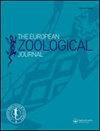在不同的生态水平上,海洋礁岩组合与基质的岩性特性是相互联系的
IF 1.4
4区 生物学
Q2 ZOOLOGY
引用次数: 2
摘要
摘要最近的研究表明,硬底质的岩性特征在影响大型藻类、固着生物和异鳃腹足类和鱼类等迷走神经动物海洋组合的多样性和结构方面发挥着重要作用。本研究旨在探索不同基质(石灰石与花岗岩)的影响是否会驱动不同迷走神经组(甲壳类动物、十足目动物、棘皮动物和鱼类)的发生。这项研究是在“Tavolara Punta Coda Cavallo”海洋保护区(地中海撒丁岛东北部)进行的,在那里,不同岩性的基质,即花岗岩和石灰岩,在当地空间尺度上出现。通过分析在30至50米深度的20个地点(10个石灰岩和10个花岗岩)收集的照片(2352张图像),研究了16种迷走神经物种(4种甲壳类动物、7种棘皮动物和5种鱼类)的多样性和丰度。统计分析显示,在两种岩性基底类型上评估的组合之间存在明显的分离,花岗岩上的组合紧密分组,石灰岩上的组合更分散。石灰岩和花岗岩的总物种丰富度没有显著差异。Galathea strigosa和Marthastrias glacialis仅在花岗岩上记录,而Palinurus elephas、Scyllarides latus、Arbacia lixula、Ophidister ophidianus和Serranus scriba仅在石灰岩上发现。观察到的模式可以部分解释为与岩性有关的多种因素:i)首选食物来源的不同可用性,可能受到基质类型的影响;ii)现场地貌,可以为不同物种提供不同的窝点和避难所(就数量和避难所类型而言);iii)不同基质的颜色根据不同物种的制服和伪装能力增强了它们的模仿能力。我们的和文献数据表明,岩礁中的基质类型可能与其他环境因素(即与深度相关的光强)相互作用,从而形成岩礁组合的结构。本文章由计算机程序翻译,如有差异,请以英文原文为准。
Marine rocky reef assemblages and lithological properties of substrates are connected at different ecological levels
Abstract Recent studies suggest that the lithological properties of hard substrates play an important role in influencing the diversity and structure of marine assemblages involving macroalgae, sessile organisms and vagile animals like heterobranchs gastropods and fishes. The present study aims at exploring whether the influence of different substrates (limestone vs granite) could drive the occurrence of different vagile groups (crustacean decapods, echinoderms and fishes). The study was carried out at the “Tavolara-Punta Coda Cavallo” Marine Protected Area (NE Sardinia, Mediterranean Sea) where substrates of different lithology, namely granites and limestones, occur on a local spatial scale. The diversity and the abundance of 16 vagile species (four crustaceans, seven echinoderms and five fishes) were investigated by the analysis of photographs (2352 images) collected in 20 sites (10 limestones and 10 granites), between 30 and 50 m depth. Statistical analyses showed a clear-cut separation between the assemblages assessed on the two lithological substrate types, with assemblages on granites that were tightly grouped and those on limestones more dispersed. The total species richness did not significantly vary between limestones and granites. Galathea strigosa and Marthasterias glacialis were exclusively recorded on granites, while Palinurus elephas, Scyllarides latus, Arbacia lixula, Ophidiaster ophidianus and Serranus scriba were exclusively found on limestones. The observed patterns could be partially explained by multiple factors related to lithology: i) the different availability of preferred food sources, potentially influenced by substrate type; ii) the site geomorphology, that could provide different dens and refuges (in terms of quantity and types of shelters) suitable for different species; iii) the colour of different substrates enhancing the mimicry of different species according to their livery and camouflage ability. Our and literature data suggest that the substrate type in rocky reefs could interact with other environmental factors (i.e., light intensity related to depth) in shaping the structure of rocky-reef assemblages.
求助全文
通过发布文献求助,成功后即可免费获取论文全文。
去求助
来源期刊

European Zoological Journal
Agricultural and Biological Sciences-Animal Science and Zoology
CiteScore
3.10
自引率
5.60%
发文量
80
审稿时长
30 weeks
期刊介绍:
The European Zoological Journal (previously Italian Journal of Zoology) is an open access journal devoted to the study of all aspects of basic, comparative and applied protozoan and animal biology at molecular, cellular, tissue, organ, organismal, population, and community-ecosystem level. Papers covering multiple levels of organization and integrative approaches to study animal form, function, development, ecology, evolution and systematics are welcome. First established in 1930 under the name of Il Bollettino di Zoologia, the journal now has an international focus, reflected through its global editorial board, and wide author and readership.
 求助内容:
求助内容: 应助结果提醒方式:
应助结果提醒方式:


